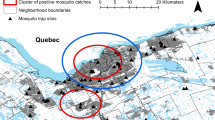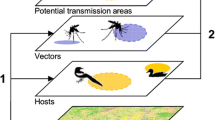Abstract
The introduction of West Nile virus (WNV) to Hawaii could have severe impacts on human health, wildlife health and, as a result, Hawaii’s tourism-based economy. To provide guidance for management agencies seeking to prevent the introduction of WNV, we performed a quantitative assessment of the pathways by which WNV could reach Hawaii from North America. We estimated the rate of infectious individuals reaching Hawaii by the following means (1) humans on aircraft, (2) wind-transported mosquitoes, (3) human-transported mosquitoes, (4) human-transported birds or other vertebrates, and (5) migratory birds. We found that pathways 3 and 4 represented the highest risk. We estimated that each year, 7–70 WNV infectious mosquitoes will reach Hawaii by airplane when WNV becomes well established in the Western U.S. Exemptions in current quarantine regulations will also result in the import of birds that will be infectious with WNV for 0.3–2.2 bird-days each year. We propose actions that would substantially reduce the risk of WNV reaching Hawaii by these means, including reinstating aircraft disinsection in cargo holds and altering bird quarantine rules. Finally, research is urgently needed to determine whether a migratory bird can survive the migration from North America to Hawaii with a viremic WNV infection.
Similar content being viewed by others
References
KA Bernard JG Maffei SA Jones EB Kauffman GD Ebel AP Dupuis et al. (2001) ArticleTitleWest Nile virus infection in birds and mosquitoes, New York State, 2000 Emerging Infectious Diseases 7 679–685
B Biggerstaff L Petersen (2002) ArticleTitleEstimated risk of West Nile virus transmission through blood transfusion during an epidemic in Queens, New York City Transfusion 42 1019–1026
CDC (2003) West Nile virus. Available: http://www.cdc.gov/ncidod/dvbid/westnile/index.htm [accessed December 8, 2003]
DBEDT-HI (2001) Annual Visitor Research Report 2000. Hawaii Department of Business, Economic Development and Tourism. Available: http://www.hawaii.gov/dbedt/00vrr/ [accessed January 15, 2004]
DOA (2003) Hawaii Administrative Rules. Title 4: Department of Agriculture. Subtitle 3: Division of Animal Industry. Chapter 28: Poultry and Birds. Available: http://www.hawaiiag.org/hdoa/adminrules/AR-28.PDF [accessed January 15, 2004]
DJ Dohm MR Sardelis MJ Turell (2002) ArticleTitleExperimental vertical transmission of West Nile virus by Culex pipiens (Diptera: Culicidae) Journal of medical Entomology 39 .
Gluzberg, Y (2004) Qualitative assessment of the major pathways by which West Nile virus can potentially be introduced into Hawaii. B.S. Thesis. Columbia University, New York, NY
DE Hardy (1960) Insects of Hawaii, Vol. 10. Diptera University of Hawaii Press Honolulu, HI
HDA (2002) Hawaii Department of Agriculture: Animal Importation and Inspection FY 2001. Available: http://www.hawaiiag.org/hdoa/leg2002/annultables.pdf. [accessed December 15, 2003]
WM Hochachka AA Dhondt KJ McGowan LD Kramer (2004) ArticleTitleImpact of West Nile virus on American crows in the northeastern United States, and its relevance to existing monitoring programs EcoHealth 1 60–68
JD Jacobi CT Atkinson (1995) Hawaii’s endemic birds ET LaRoe GS Farris CE Puckett PD Doran MJ Mac (Eds) Our Living Resources: A Report to the Nation on the Distribution, Abundance and Health of U.S. Plants, Animals, and Ecosystems U.S Department of Interior, National Biological Service Washington DC 376–381
N Komar NA Panella JE Burns SW Dusza TM Mascarenhas TO Talbot (2001) ArticleTitleSerologic evidence for West Nile virus infection in birds in the New York City vicinity during an outbreak in 1999 Emerging Infectious Diseases 7 621–625
N Komar S Langevin S Hinten N Nemeth E Edwards D Hettler et al. (2003) ArticleTitleExperimental infection of north American birds with the New York 1999 strain of West Nile virus Emerging Infectious Diseases 9 311–322
M Kostyukov A Alekseev V Bulychev Z Gordeeva (1986) ArticleTitleExperimental infection of Culex piyiens mosquitoes with West Nile virus by feeding on infected Rana ridibunda frogs and its subsequent transmission Meditsinskaia Parazitologiia I Parazitarnye Bolezni (Moskra) 6 76–78
SA Langevin M Bunning B Davis N Komar (2001) ArticleTitleExperimental infection of chickens as candidate sentinels for West Nile virus Emerging Infectious Diseases 7 726–729
MAF (2003) Sea Container Review. Government Report, New Zealand Ministry of Agriculture and Forestry, Wellington, NZ
T Oda Y Eshita K Uchida M Mine K Kurokawa Y Ogawa et al. (2002) ArticleTitleReproductive activity and survival of Culex pipiens pollens and Culex, quinquefasciatus (Diptera: Culicidae) in Japan at high temperature Journal of Medical Entomology 39 185–190
Pape J (2004) The human and governmental costs of West Nile virus. Protecting Hawaii and the Pacific from West Nile Virus Conference, Honolulu, HI, January 7–8, 2004
R Russell N Rajapaksa P Whelan W Langsford (1984) Mosquito and other insect introductions to Australia aboard international aircraft and the monitoring of disinfection procedures M Laird (Eds) Commerce and the Spread of Pests and Disease Vectors Praeger New York 109–141
MR Sardelis MJ Turell DJ Dohm ML O’Guinn (2001) ArticleTitlevector competence of selected North American Culex and Coquillettidia mosquitoes for West Nile virus Emerging Infectious Diseases 7 1018–1022
M Sardelis M Turell M O’Guinn R Andre D Roberts (2002) ArticleTitleVector competence of three North American strains of Aedes albopictus for West Nile virus Journal of the American mosquito Control Association 18 284–289
S Takahashi (1984) Survey on accidental introductions of insects entering Japan via aircraft M Laird (Eds) Commerce and the Spread of Pests and Disease Vectors Praeger New York 65–79
C Van Riper SuffixIII SG Van Riper ML Goff M Laird (1986) ArticleTitleThe epizootiology and ecological significance of malaria in Hawaiian (USA) land birds Ecological Monographs 56 327–344
Acknowledgments
We thank members of the January 2004 Hawaii WNV conference for helpful comments and suggestions, and Nick Komar for providing the raw viremia data from experimental infections of birds. Funding was provided by NIAID-NIH contract NO1-AI-25490 to L. Kramer, and core funding to the Consortium for Conservation Medicine at Wildlife Trust from the V. Kann Rasmussen Foundation.
Author information
Authors and Affiliations
Corresponding author
Rights and permissions
About this article
Cite this article
Kilpatrick, A.M., Gluzberg, Y., Burgett, J. et al. Quantitative Risk Assessment of the Pathways by Which West Nile Virus Could Reach Hawaii. EcoHealth 1, 205–209 (2004). https://doi.org/10.1007/s10393-004-0086-6
Published:
Issue Date:
DOI: https://doi.org/10.1007/s10393-004-0086-6




